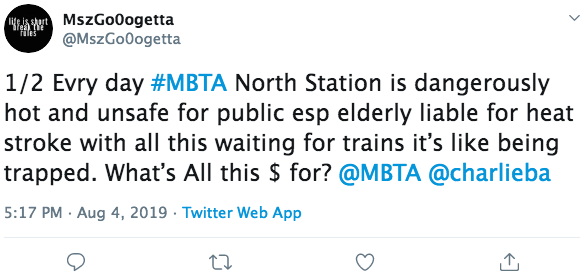One thing to be thankful about as a CTA straphanger is that even when Chicago is experiencing a heat wave, the temperature usually isn't too awful on 'L' platforms, within subway station, and on trains and buses. I recently learned that the same can't be said for all peer transit systems.
This past week, I was in Boston with the TransitCenter foundation's Women Changing Transportation Mentorship Program. We were attending the American Public Transportation Association's Sustainability and Multimodal Planning Workshop.
While there, I took some time to visit different parts of Boston with other mentees in the program. I am always particularly excited about riding transit in other cities. On one day, a fellow mentee and I went to Harvard Square from Back Bay. It’s not particularly far, so we walked to the Park Street T Stop near Boston Common to ride the Red Line.

During the days we were there, it was extremely hot, which was impacting train speeds. Boston’s mayor even declared a “heat emergency” a few weeks ago. The heat was palpable when we were walking down the street, which was made worse by the fact there was little shade (where were all the street trees?). Once we got to the station, we then had to navigate the facility to find our platform. By this point, we were already heat-exhausted and the humidity in the station was worse. The only cooling came from fans placed haphazardly throughout the station. Luckily, the actual train cars were cool, which offered a much-needed reprieve. As someone who rides the CTA frequently, I seldom encounter stations that mirror the heat outside.
A few days later, another mentee and I were heading to the conference center from the Back Bay Orange Line station. Another heat-stroke-inducing platform awaited us. 20-30 minutes passed before a train arrived that we could board (they were all packed). Within a few stops, a woman collapsed on our rail car. By the time someone came to help her, she had come to. She was drenched with sweat and I'd venture to guess the extreme heat on the platform did not help.

I’d ridden the T before, but never in peak summer. It was not pleasant. On one of our tours that week, we learned that Boston has the oldest subway in the United States, which explains its aging infrastructure. It’s not the first time people have noted the heat on the Boston T.
When I spoke to other mentees from other cities, they said that the New York subway is no better when it comes to heat. Last time I visited, I mostly rode the 7 above ground, so at least there was some air circulation, just like on Chicago 'L' platforms. NYC’s MTA has noted the aging infrastructure and its Subway Action Plan includes a strategy to modernize the system and address its issues with climate control.

Since I was just a visitor to Boston, I wanted to see what locals had to say about the hot subway, so I scoured Twitter for tweets about the heat on the subway. Unsurprisingly, there were a lot of frustrated tweets.
As our cities experience more heat waves and climate change becomes an everyday reality, I wonder how our transportation systems are preparing for the extreme heat, whether in regards to the heat on the tracks or the safety of customers on a hot platform. These are questions we all need to be asking and working to address.






